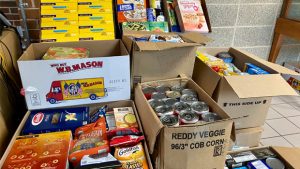With the pandemic exacerbating food insecurity, hundreds of thousands of Connecticut residents have been struggling with hunger; more than 150,000 of them are children. Fortunately, teachers have stepped in to help.
As schools shut down last spring and summer, cutting many students off from a primary source of their daily nutrition, teachers quickly mobilized. Many volunteered hours of their time evenings and weekends to collect and distribute food to families in need.
This summer, CEA members continue to take up the cause.
“Our members care deeply about their students and know what a difficult year it’s been for so many of them,” says CEA Regional Organizer Brendan Murphy. “They know firsthand that food insecurity threatens children’s health and development and causes greater difficulty in school. In spite of so many other demands placed on our educators since the start of the pandemic, they continue to do everything in their power to ensure their students are not undernourished or overlooked.”
From late May through mid-June this year, teachers organized food drives at their schools, collecting nonperishable items such as canned fruit and vegetables, dried beans, canned soup, tuna, and chicken, shelf-stable milk and juice, peanut butter, and dried herbs and spices.
Avon Education Association President Jon Moss notes that his district’s Pine Grove School collected more than 800 items for Gifts of Love, a local charitable organization with which the town has longstanding ties.
“The teacher who organized this great event is the wonderful Michelle Gladue, a fourth-grade teacher at Pine Grove,” says Moss. “She always finds opportunities to teach her students the importance of helping others and being civic-minded individuals. When she heard that we wanted to organize a food drive, she didn’t hesitate to volunteer as a leader. She worked with her students to publicize the event, make signs, and count up the contributions as they came in.”
“A lot of people are in need,” Gladue (pictured) explains, “including many who find themselves in circumstances they didn’t expect—loss of a job, illness, or loss of a loved one. We live in one of the richest states in one of the richest countries in the world. If everyone gave what they could when they could—whether it is time, money, or both—our world would be a better place. And if I want change, I need to be a part of it. This was something small I could do.”

Before the school year ended, Avon teachers and students collected hundreds of donations to feed the hungry.
Gladue’s students helped by contributing to the food drive and creating posters explaining why some people had difficulty affording food.
“One of my students commented that he loved coming into school and watching the thermometer rise on the poster we made as the number of items collected increased. It was also rewarding to see the faces of the students light up as they were thanked for the groceries they contributed. It was cool for the kids to see the boxes fill up and realize their small contributions added up to make a big difference.”
“Though we were winding down and looking forward to summer, we also realized the importance of helping people in need,” explains Jon Jette, president of East Windsor Education Association, where teachers in three schools took the lead in organizing their local food drive.
One of those teachers, Broad Brook School’s Elaine Shapiro, who serves on EWEA’s executive board, helped collect several grocery bags’ worth of food from a list provided by FoodShare.
“I see the need for families and the toll this year has taken on them,” she says. “Donating food is a clear way to help them.”
“Even though the economy is picking up and many people are going back to work, the need is still there,” says Jette. “This becomes even more crucial during times when school is not in session, because many students get at least one, if not two, of their meals at school.”







